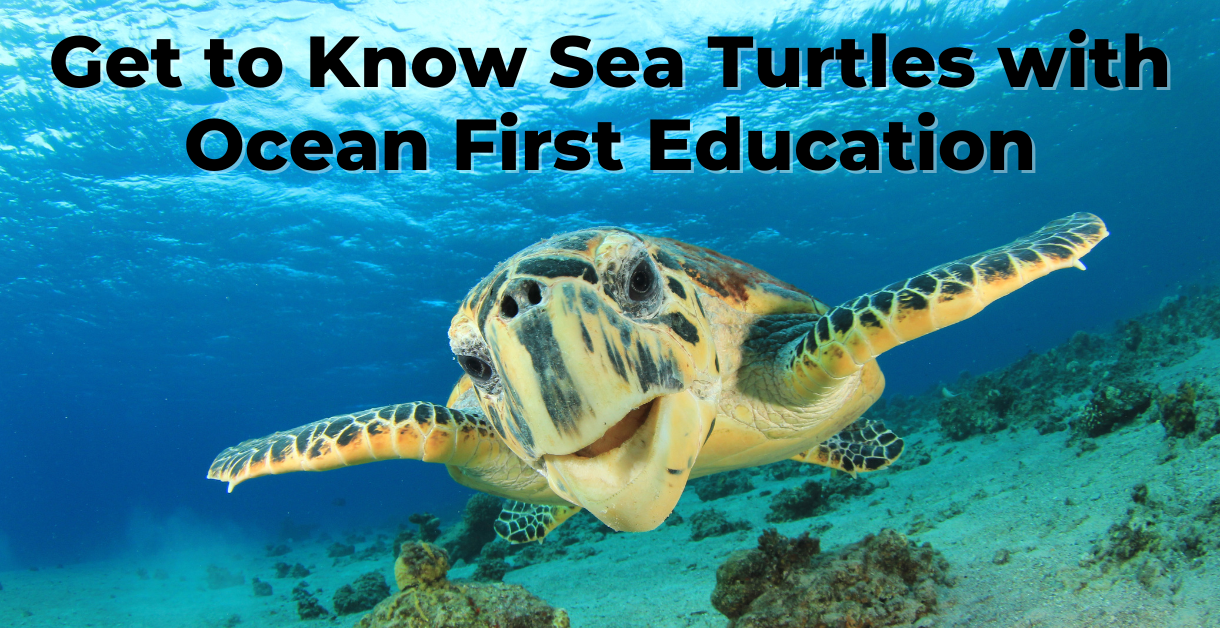Sea turtles are one of the few examples of marine reptiles. Today, seven species of sea turtles exist around the world. Six of the seven species can be found in the waters of the United States. Unfortunately, all seven species of sea turtle are listed as either threatened or endangered. However, the more we know about these amazing animals, the better we can understand and protect them.

A green sea turtle comes in for a closer look.
Photo credit: Ocean First Education
Get to know sea turtles by exploring the five facts below.
● Sea turtles are reptiles with flippers and a shell. Unlike other turtles, sea turtles cannot retract their limbs and head inside their shells.
● Female sea turtles return to the beach where they hatched to lay their eggs. How they find their way is still a mystery, but scientists think the turtles use chemical and magnetic signals to navigate.
● Female turtles come ashore at night to dig their nests and lay their eggs, leaving a track called a “crawl”. Species can be identified by the unique shape of their crawl.
● For sea turtles, whether the hatchlings are male or female is determined by the incubation temperature of the eggs. Research shows that incubation temperatures below 82°F result in male hatchlings and incubation temperatures above 87°F result in female hatchlings. Incubation temperatures that fluctuate within this range produce a mix of males and females.
● Sea turtles spend most of their lives in the ocean, migrating thousands of miles over the course of months to years! Leatherback sea turtles are among the most highly migratory animals on Earth, traveling as many as 10,000 miles each year between foraging grounds in search of sea jellies.
If you’d like to learn even more about these amazing and ancient animals, check out the Ocean First Education Sea Turtle Ecology short course and/or the Green Sea Turtle and Hawksbill Sea Turtle Explorer Series.
Plus, join us on June 22, 2022, at 11:00 AM PT for a free Get to Know Sea Turtles webinar where students will explore the identifying features and adaptations of all seven species of sea turtles. Students will then learn how to identify sea turtle species using a tool called a dichotomous key, just as real-world scientists do while studying sea turtles in the wild.
![]() Chrissy Frederick spent 20 years as a classroom science teacher in both public and independent schools. She now brings her passion for science to her role as an instructional designer with Ocean First Education (OFE).
Chrissy Frederick spent 20 years as a classroom science teacher in both public and independent schools. She now brings her passion for science to her role as an instructional designer with Ocean First Education (OFE).
At OFE, students are taken to the intersection of fascination and education, through engaging, relevant, and student-centered learning experiences.
We want to thank our friends from Ocean First Education for sharing with us today. Curriculum from Ocean First Education provides in-depth, multidisciplinary instruction that guides students towards a greater understanding and appreciation of marine science and ocean conservation. Receive 25% off Ocean First Education's fascinating curriculum at the Homeschool Buyers Club here.


